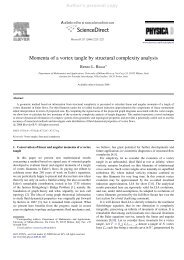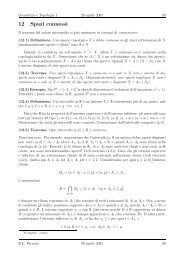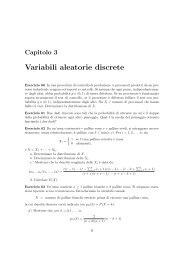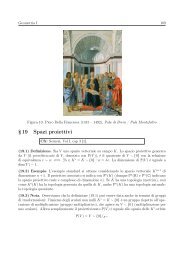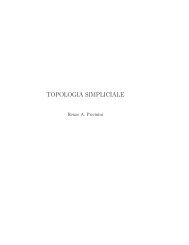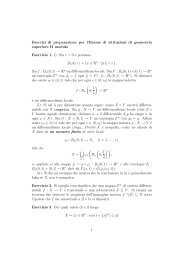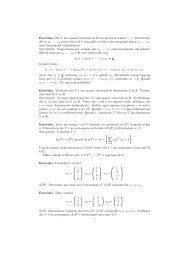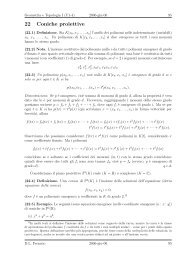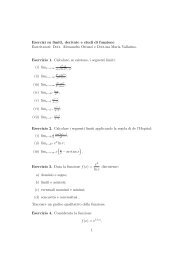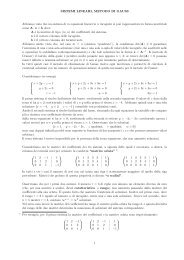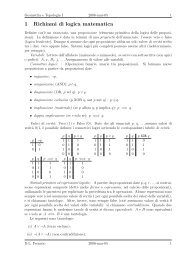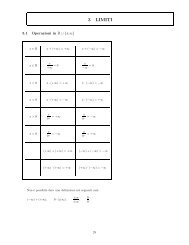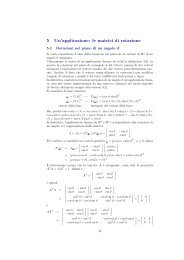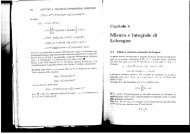Permutation representations of finite simple groups: Orbits of cyclic ...
Permutation representations of finite simple groups: Orbits of cyclic ...
Permutation representations of finite simple groups: Orbits of cyclic ...
Create successful ePaper yourself
Turn your PDF publications into a flip-book with our unique Google optimized e-Paper software.
<strong>Permutation</strong> <strong>representations</strong><br />
<strong>of</strong> <strong>finite</strong> <strong>simple</strong> <strong>groups</strong>:<br />
<strong>Orbits</strong> <strong>of</strong> <strong>cyclic</strong> sub<strong>groups</strong><br />
Milano, 13 May 2009<br />
Johannes Siemons, UEA Norwich
Let n ≥ k be integers, k not a prime power. Consider a <strong>cyclic</strong><br />
subgroup<br />
C ⊆ Sym n<br />
in the symmetric group on {1..n}, <strong>of</strong> order k. Then the size <strong>of</strong><br />
any C -orbit α C divides k. We say that C has a regular orbit if<br />
|α C | = |C| for some α ∈ {1..n}.
Let n ≥ k be integers, k not a prime power. Consider a <strong>cyclic</strong><br />
subgroup<br />
C ⊆ Sym n<br />
in the symmetric group on {1..n}, <strong>of</strong> order k. Then the size <strong>of</strong><br />
any C -orbit α C divides k. We say that C has a regular orbit if<br />
|α C | = |C| for some α ∈ {1..n}.<br />
We are interested in the following question: If C has no<br />
regular orbit on {1..n}, does there exist a <strong>simple</strong> group G,<br />
not an alternating group, such that<br />
C ⊂ G ⊂ Sym n
The answer is that there should be no such <strong>simple</strong> group.
The answer is that there should be no such <strong>simple</strong> group.<br />
Questions <strong>of</strong> this kind belong to a project in which Alex has been<br />
a leading force: Recognition <strong>of</strong> <strong>finite</strong> <strong>simple</strong> <strong>groups</strong> by the<br />
properties <strong>of</strong> a single element.
The answer is that there should be no such <strong>simple</strong> group.<br />
Questions <strong>of</strong> this kind belong to a project in which Alex has been<br />
a leading force: Recognition <strong>of</strong> <strong>finite</strong> <strong>simple</strong> <strong>groups</strong> by the<br />
properties <strong>of</strong> a single element.<br />
To recognize an almost <strong>simple</strong> permutation group by a single<br />
element becomes feasible due to the O’Nan Scott Theorem: If<br />
G is maximal, not containing Alt n , with<br />
G ⊂ Sym n<br />
then G belongs to one <strong>of</strong> 5 well-understood classes, or otherwise,<br />
is almost <strong>simple</strong>.
Therefore, given g ∈ Sym n with regular orbits, can we identify<br />
the primitive almost <strong>simple</strong> <strong>groups</strong> G with<br />
〈 g 〉 ⊂ G ⊂ Sym n <br />
The problem I first mentioned is a key step towards answering<br />
such questions. I will report about joint work with Alex Zalesskii.
Therefore, given g ∈ Sym n with regular orbits, can we identify<br />
the primitive almost <strong>simple</strong> <strong>groups</strong> G with<br />
〈 g 〉 ⊂ G ⊂ Sym n <br />
The problem I first mentioned is a key step towards answering<br />
such questions. I will report about joint work with Alex Zalesskii.<br />
Initial Comments [1] : Let C, B ⊆ A be <strong>finite</strong> <strong>groups</strong>. Then C<br />
has a regular orbit on the cosets <strong>of</strong> B in A if and only if<br />
C ∩ B a ⊆ K<br />
for some a ∈ A, where K is the core <strong>of</strong> B in A.
For <strong>cyclic</strong> C let the square-free part <strong>of</strong> the action be the subgroup<br />
C ′ such that if the prime p divides |C : C ∩ K| then p<br />
divides |C ′ : C ′ ∩ K| but not p 2 . A <strong>simple</strong> reduction is<br />
Lemma: C has a regular orbit on the cosets <strong>of</strong> B in A if and<br />
only if C ′ has a regular orbit on this set.<br />
There is much work on intersections <strong>of</strong> conjugacy classes <strong>of</strong><br />
sub<strong>groups</strong>, and in some sense this is the main task in tackling<br />
the problem.
[2] : Let (G, Ω) be an action <strong>of</strong> the group G on the set Ω. Denote<br />
F := C and consider the permutation module F Ω for F G.<br />
For <strong>cyclic</strong> <strong>groups</strong> the permutation module is crucial in detecting<br />
regular orbits.
[2] : Let (G, Ω) be an action <strong>of</strong> the group G on the set Ω. Denote<br />
F := C and consider the permutation module F Ω for F G.<br />
For <strong>cyclic</strong> <strong>groups</strong> the permutation module is crucial in detecting<br />
regular orbits.<br />
Lemma (Brauer, 1940): Two n × n permutation matrices are<br />
conjugate in GL(n, C) if and only if the corresponding permutations<br />
are similar (the same up to renaming) in Sym n .<br />
In other words: for <strong>cyclic</strong> C we have F Ω ∼ = F ∆ as F C -modules<br />
if and only if (C, Ω) ∼ = (C, ∆) as G-sets. This lemma turns out<br />
to be very useful for our purposes.
It is a special case <strong>of</strong> a Theorem <strong>of</strong> Burnside, we will come<br />
back to this later.<br />
Example: Look at two elements <strong>of</strong> order 6. First take g =<br />
(1, 2)(3, 4, 5)(6). It has eigenvalues λ i , µ j and ν satisfying λ 2 i =<br />
µ 3 j<br />
= ν = 1. Correspondingly,<br />
F Ω = 3I 1 + I 2 + I 3 + I 4 .
It is a special case <strong>of</strong> a Theorem <strong>of</strong> Burnside, we will come<br />
back to this later.<br />
Example: Look at two elements <strong>of</strong> order 6. First take g =<br />
(1, 2)(3, 4, 5)(6). It has eigenvalues λ i , µ j and ν satisfying λ 2 i =<br />
µ 3 j<br />
= ν = 1. Correspondingly,<br />
F Ω = 3I 1 + I 2 + I 3 + I 4 .<br />
On the other hand, if g = (1, 2, 3, 4, 5, 6) then its eigenvalues are<br />
the 6 distinct roots <strong>of</strong> unity and<br />
F Ω = I 1 + I 2 + I 3 + I 4 + I 5 + I 6 .
The key observation is therefore that the <strong>cyclic</strong> C <strong>of</strong> order k<br />
has an orbit <strong>of</strong> length k = |C| if and only if the module for a<br />
primitive k th root <strong>of</strong> unity appears in F Ω. Our version <strong>of</strong> the<br />
Burnside-Brauer Lemma is
The key observation is therefore that the <strong>cyclic</strong> C <strong>of</strong> order k<br />
has an orbit <strong>of</strong> length k = |C| if and only if the module for a<br />
primitive k th root <strong>of</strong> unity appears in F Ω. Our version <strong>of</strong> the<br />
Burnside-Brauer Lemma is<br />
Lemma (Siemons & Zalesski, 2002): Let C be a <strong>cyclic</strong> permutation<br />
group on Ω. Then the number <strong>of</strong> regular orbits <strong>of</strong> C on<br />
Ω is the multiplicity <strong>of</strong> the regular module F C in F Ω.
PLAN FOR REMAINDER OF THIS TALK<br />
• Main Theorem<br />
• Idea <strong>of</strong> the Pro<strong>of</strong><br />
• Embeddings <strong>of</strong> <strong>Permutation</strong> Groups
Main Theorem<br />
Let G be an almost <strong>simple</strong> group, X ⊆ G ⊆ Aut X, with socle<br />
X. We are interested in the following two lists:<br />
L1: G has a doubly transitive permutation representation:<br />
• PSL(n, q) on points/hyperplanes <strong>of</strong> projective space,<br />
• Symplectic group Sp(2n, 2) on Ω + and Ω − ,<br />
• Unitary group PSU(3, q) on 1-dim isotropic subspaces,<br />
• Suzuki group Sz(q) = 2 B 2 (q) on points <strong>of</strong> inversive plane,<br />
• Ree group R(q) = 2 G 2 (q) on points <strong>of</strong> Ree unital,<br />
• M 11 , M 12 , M 22 , M 23 , M 24 , HS <strong>of</strong> degree 176, and Co 3 <strong>of</strong><br />
degree 276.
L2: G is a classical group, not already listed in L1:<br />
• Symplectic <strong>groups</strong> PSp(2n, q),<br />
• Unitary <strong>groups</strong> PSU(n, q),<br />
• Orthogonal <strong>groups</strong> O(2n + 1, q), O + (2n, q), O − (2n, q).
L2: G is a classical group, not already listed in L1:<br />
• Symplectic <strong>groups</strong> PSp(2n, q),<br />
• Unitary <strong>groups</strong> PSU(n, q),<br />
• Orthogonal <strong>groups</strong> O(2n + 1, q), O + (2n, q), O − (2n, q).<br />
Let L be the union <strong>of</strong> L1 and L2 but remove any group whose<br />
socle is an alternating group. A group in L acts non-trivially<br />
on the set ∆ if its socle is not the identity group on ∆.
L2: G is a classical group, not already listed in L1:<br />
• Symplectic <strong>groups</strong> PSp(2n, q),<br />
• Unitary <strong>groups</strong> PSU(n, q),<br />
• Orthogonal <strong>groups</strong> O(2n + 1, q), O + (2n, q), O − (2n, q).<br />
Let L be the union <strong>of</strong> L1 and L2 but remove any group whose<br />
socle is an alternating group. A group in L acts non-trivially<br />
on the set ∆ if its socle is not the identity group on ∆.<br />
Theorem (Emmett, Siemons & Zalesski, 2000, ’02, ’10): Let<br />
G be in L and suppose that G acts non-trivially on the set ∆.<br />
Then every <strong>cyclic</strong> subgroup <strong>of</strong> G has a regular orbit on ∆.
It is expected that the theorem holds more generally for all almost<br />
<strong>simple</strong> <strong>groups</strong> with socle not equal to an alternating group.
It is expected that the theorem holds more generally for all almost<br />
<strong>simple</strong> <strong>groups</strong> with socle not equal to an alternating group.<br />
Primitive <strong>groups</strong> in which <strong>cyclic</strong> sub<strong>groups</strong> do not have a regular<br />
orbit seem to be rare, unless the group is related to some action<br />
<strong>of</strong> an alternating group.<br />
For instance, by direct computation one can see that in a primitive<br />
<strong>groups</strong> <strong>of</strong> degree < 50 all <strong>cyclic</strong> sub<strong>groups</strong> have regular<br />
orbits, unless the action is related to an alternating group.
Idea <strong>of</strong> the Pro<strong>of</strong><br />
A mixture <strong>of</strong> the two techniques already mentioned is needed:<br />
intersections <strong>of</strong> conjugacy classes <strong>of</strong> sub<strong>groups</strong> and embeddings<br />
<strong>of</strong> permutation modules.
Idea <strong>of</strong> the Pro<strong>of</strong><br />
A mixture <strong>of</strong> the two techniques already mentioned is needed:<br />
intersections <strong>of</strong> conjugacy classes <strong>of</strong> sub<strong>groups</strong> and embeddings<br />
<strong>of</strong> permutation modules.<br />
1. Embeddings: Let G be in L1, acting doubly transitively on<br />
the set Ω. Suppose that G also acts non-trivially on some other<br />
set ∆. Consider the corresponding F G-modules F Ω and F ∆.<br />
Let<br />
ϕ: F Ω → F ∆<br />
be a non-zero F G-homomorphism. Then its kernel can only be<br />
0, I or F Ω − I.
Proposition: Let G be doubly transitive on Ω and let ∆ be a<br />
transitive G-set. Then exactly one <strong>of</strong> the following is true:<br />
(i) There exists an injective F G-homorphism ϕ: F Ω → F ∆,<br />
(ii) G = G ω · G δ for all ω ∈ Ω and δ ∈ ∆.
Proposition: Let G be doubly transitive on Ω and let ∆ be a<br />
transitive G-set. Then exactly one <strong>of</strong> the following is true:<br />
(i) There exists an injective F G-homorphism ϕ: F Ω → F ∆,<br />
(ii) G = G ω · G δ for all ω ∈ Ω and δ ∈ ∆.<br />
In particular, in the embedding case (i), if a <strong>cyclic</strong> subgroup C<br />
has a regular orbit on Ω then C has a regular orbit on ∆, by<br />
the Lemma on <strong>cyclic</strong> permutation modules. So we are done in<br />
this case.
Proposition: Let G be doubly transitive on Ω and let ∆ be a<br />
transitive G-set. Then exactly one <strong>of</strong> the following is true:<br />
(i) There exists an injective F G-homorphism ϕ: F Ω → F ∆,<br />
(ii) G = G ω · G δ for all ω ∈ Ω and δ ∈ ∆.<br />
In particular, in the embedding case (i), if a <strong>cyclic</strong> subgroup C<br />
has a regular orbit on Ω then C has a regular orbit on ∆, by<br />
the Lemma on <strong>cyclic</strong> permutation modules. So we are done in<br />
this case.<br />
In case (ii) all factorizations are known by the results <strong>of</strong> Liebeck,<br />
Praeger and Saxl. The list <strong>of</strong> factorizations is short, thankfully.
2. Intersections <strong>of</strong> conjugacy classes: Let G be in L1,<br />
acting doubly transitively on Ω and ω ∈ Ω. Let C = 〈 g 〉 be<br />
<strong>cyclic</strong>, square-free without loss. One needs to show that<br />
for some a ∈ G.<br />
C ∩ (G ω ) a = 1
2. Intersections <strong>of</strong> conjugacy classes: Let G be in L1,<br />
acting doubly transitively on Ω and ω ∈ Ω. Let C = 〈 g 〉 be<br />
<strong>cyclic</strong>, square-free without loss. One needs to show that<br />
for some a ∈ G.<br />
C ∩ (G ω ) a = 1<br />
This requires case by case analysis. In the linear situation induction<br />
over the number <strong>of</strong> Jordan blocks <strong>of</strong> g on the underlying<br />
vector space can be used. Similar comments apply to the factorization<br />
case. This completes the list L1.<br />
The <strong>groups</strong> in L2 all have rank 3 actions. However, as yet this<br />
can not be used. So also here intersection type arguments are<br />
needed. Technically quite involved!
Embeddings<br />
Comment 1: As an example, let G = P SL(n, p) acts on Ω =<br />
points <strong>of</strong> projective space. Let ∆ be any other G-set, and<br />
assume that we are in the embedding case. Take some g ∈ G.
Embeddings<br />
Comment 1: As an example, let G = P SL(n, p) acts on Ω =<br />
points <strong>of</strong> projective space. Let ∆ be any other G-set, and<br />
assume that we are in the embedding case. Take some g ∈ G.<br />
How does g act on ∆ For instance, if g is a transvection<br />
then some part <strong>of</strong> ∆ looks exactly like Ω : many fixed points,<br />
with the remainder all cycles <strong>of</strong> length p.
Embeddings<br />
Comment 1: As an example, let G = P SL(n, p) acts on Ω =<br />
points <strong>of</strong> projective space. Let ∆ be any other G-set, and<br />
assume that we are in the embedding case. Take some g ∈ G.<br />
How does g act on ∆ For instance, if g is a transvection<br />
then some part <strong>of</strong> ∆ looks exactly like Ω : many fixed points,<br />
with the remainder all cycles <strong>of</strong> length p.<br />
Similarly, let g be a Singer cycle. Again, some part <strong>of</strong> ∆ looks<br />
exactly like Ω : at least one cycle <strong>of</strong> length (p n − 1)/(n − 1), with<br />
other shorter cycles, etc.
Embeddings<br />
Comment 1: As an example, let G = P SL(n, p) acts on Ω =<br />
points <strong>of</strong> projective space. Let ∆ be any other G-set, and<br />
assume that we are in the embedding case. Take some g ∈ G.<br />
How does g act on ∆ For instance, if g is a transvection<br />
then some part <strong>of</strong> ∆ looks exactly like Ω : many fixed points,<br />
with the remainder all cycles <strong>of</strong> length p.<br />
Similarly, let g be a Singer cycle. Again, some part <strong>of</strong> ∆ looks<br />
exactly like Ω : at least one cycle <strong>of</strong> length (p n − 1)/(n − 1), with<br />
other shorter cycles, etc.<br />
QUESTION 1: Is is possible to identify G from such orbit<br />
statistics
Comment 2: Moving on from <strong>cyclic</strong> sub<strong>groups</strong> <strong>of</strong> G, does a<br />
nilpotent subgroup have regular orbits
Comment 2: Moving on from <strong>cyclic</strong> sub<strong>groups</strong> <strong>of</strong> G, does a<br />
nilpotent subgroup have regular orbits<br />
Theorem (B Bailey Hargraves, 1980): Let V be a <strong>finite</strong>dimensional<br />
space over GF (q). Suppose that D ⊆ GL(V ) is<br />
nilpotent with (|D|, q) = 1. Then D has a regular orbit on V,<br />
apart from a short list <strong>of</strong> exceptions.
Comment 2: Moving on from <strong>cyclic</strong> sub<strong>groups</strong> <strong>of</strong> G, does a<br />
nilpotent subgroup have regular orbits<br />
Theorem (B Bailey Hargraves, 1980): Let V be a <strong>finite</strong>dimensional<br />
space over GF (q). Suppose that D ⊆ GL(V ) is<br />
nilpotent with (|D|, q) = 1. Then D has a regular orbit on V,<br />
apart from a short list <strong>of</strong> exceptions.<br />
So let G = P SL(n, p) act on Ω = points <strong>of</strong> projective space,<br />
and suppose that a nilpotent D ⊂ G has a regular orbit on Ω.<br />
Let again ∆ be an arbitrary G-set, in the embedding case.
Comment 2: Moving on from <strong>cyclic</strong> sub<strong>groups</strong> <strong>of</strong> G, does a<br />
nilpotent subgroup have regular orbits<br />
Theorem (B Bailey Hargraves, 1980): Let V be a <strong>finite</strong>dimensional<br />
space over GF (q). Suppose that D ⊆ GL(V ) is<br />
nilpotent with (|D|, q) = 1. Then D has a regular orbit on V,<br />
apart from a short list <strong>of</strong> exceptions.<br />
So let G = P SL(n, p) act on Ω = points <strong>of</strong> projective space,<br />
and suppose that a nilpotent D ⊂ G has a regular orbit on Ω.<br />
Let again ∆ be an arbitrary G-set, in the embedding case.<br />
QUESTION 2: Does C have a regular orbit on ∆
Here the lemma for permutation modules <strong>of</strong> <strong>cyclic</strong> <strong>groups</strong> can<br />
not be applied any longer. Instead we need to recall a theorem<br />
<strong>of</strong> Burnside that is not so well-known any longer.<br />
If G acts on Ω and if U ⊆ G let fix Ω (U) be the number <strong>of</strong><br />
elements ω ∈ Ω fixed by all elements <strong>of</strong> U. (This function extends<br />
the permutation character to sub<strong>groups</strong>.)
Here the lemma for permutation modules <strong>of</strong> <strong>cyclic</strong> <strong>groups</strong> can<br />
not be applied any longer. Instead we need to recall a theorem<br />
<strong>of</strong> Burnside that is not so well-known any longer.<br />
If G acts on Ω and if U ⊆ G let fix Ω (U) be the number <strong>of</strong><br />
elements ω ∈ Ω fixed by all elements <strong>of</strong> U. (This function extends<br />
the permutation character to sub<strong>groups</strong>.)<br />
Theorem (Burnside, 1911): Let (G, Ω) and (G, ∆) be permutation<br />
actions. Then (G, Ω) = ∼ (G, ∆) if and only if fix Ω (U) =<br />
fix ∆ (U) for all sub<strong>groups</strong> U in G.
Here the lemma for permutation modules <strong>of</strong> <strong>cyclic</strong> <strong>groups</strong> can<br />
not be applied any longer. Instead we need to recall a theorem<br />
<strong>of</strong> Burnside that is not so well-known any longer.<br />
If G acts on Ω and if U ⊆ G let fix Ω (U) be the number <strong>of</strong><br />
elements ω ∈ Ω fixed by all elements <strong>of</strong> U. (This function extends<br />
the permutation character to sub<strong>groups</strong>.)<br />
Theorem (Burnside, 1911): Let (G, Ω) and (G, ∆) be permutation<br />
actions. Then (G, Ω) = ∼ (G, ∆) if and only if fix Ω (U) =<br />
fix ∆ (U) for all sub<strong>groups</strong> U in G.<br />
THANK YOU
Pro<strong>of</strong>: Let G 1 , .., G t be a system <strong>of</strong> representative for the<br />
conjugacy classes <strong>of</strong> sub<strong>groups</strong> <strong>of</strong> G. Let Ω i := G/G i be the<br />
corresponding G-sets, obtained by right multiplication. Suppose<br />
Ω = ∑ n i Ω i and Ω ′ = ∑ n ′ i Ω i<br />
are G-sets with fix Ω (U) = fix Ω ′(U) for all sub<strong>groups</strong> U in G.
Pro<strong>of</strong>: Let G 1 , .., G t be a system <strong>of</strong> representative for the<br />
conjugacy classes <strong>of</strong> sub<strong>groups</strong> <strong>of</strong> G. Let Ω i := G/G i be the<br />
corresponding G-sets, obtained by right multiplication. Suppose<br />
Ω = ∑ n i Ω i and Ω ′ = ∑ n ′ i Ω i<br />
are G-sets with fix Ω (U) = fix Ω ′(U) for all sub<strong>groups</strong> U in G.<br />
Let J be the set <strong>of</strong> all i for which n i ≠ n ′ i<br />
. Select j ∈ J so that<br />
G j is maximal (wrt subconjugacy) among all G i with i ∈ J. Then<br />
0 = fix Ω (G j ) − fix Ω ′(G j ) = ∑ (n i − n ′ i ) · fix Ω i<br />
(G j ).<br />
i∈J
Pro<strong>of</strong>: Let G 1 , .., G t be a system <strong>of</strong> representative for the<br />
conjugacy classes <strong>of</strong> sub<strong>groups</strong> <strong>of</strong> G. Let Ω i := G/G i be the<br />
corresponding G-sets, obtained by right multiplication. Suppose<br />
Ω = ∑ n i Ω i and Ω ′ = ∑ n ′ i Ω i<br />
are G-sets with fix Ω (U) = fix Ω ′(U) for all sub<strong>groups</strong> U in G.<br />
Let J be the set <strong>of</strong> all i for which n i ≠ n ′ i<br />
. Select j ∈ J so that<br />
G j is maximal (wrt subconjugacy) among all G i with i ∈ J. Then<br />
0 = fix Ω (G j ) − fix Ω ′(G j ) = ∑ i∈J<br />
(n i − n ′ i ) · fix Ω i<br />
(G j ).<br />
Now fix Ωi (G j ) ≠ 0 only if G j is subconjugate to G i . So, only if<br />
i = j by maximality. Hence<br />
0 = ∑ i∈J<br />
(n i − n ′ i ) · fix Ω i<br />
(G j ) = (n j − n ′ j ) · fix Ω j<br />
(G j ) > 0<br />
which means that J = ∅.



